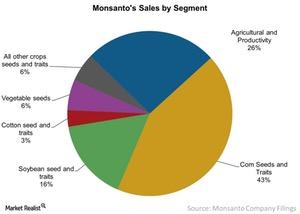This Segment Has Become Important for Monsanto in the Last Decade
Monsanto (MON) conducts its global sales through two broad segments known as the Seeds & Genomics and Agricultural Productivity segments.
Dec. 30 2016, Published 1:28 p.m. ET

Monsanto’s segments
Monsanto (MON) conducts its global sales through two broad segments known as the Seeds & Genomics and Agricultural Productivity segments.
The Seed & Genomics segment contributed ~74% toward Monsanto’s 2016 sales, while the Agricultural Productivity segment contributed the remaining 26%.
Segment growth
Over the past decade, there’s been a clear direction in which sales contributions from the two above-mentioned segments have trended. The share of Seed & Genomics toward Monsanto’s total sales has risen from 56% in 2006 to 74% in 2016, while the opposite has happened for Agricultural Productivity.
The Agricultural Productivity segment’s sales have fallen from 44% in 2006 to 26% in 2016, implying the growing importance of the Seed & Genomics segment.
Seed & Genomics
The Seed & Genomics segment includes business from global seeds and traits, digital agriculture, and biotechnology platforms. The company has broken this segment down into five reportable subsegments. Their names and contributions to Monsanto’s total 2016 sales are as follows:
- corn seed and traits: 43%
- soybean seed and traits: 16%
- cotton seed and traits: 3%
- vegetable seeds: 6%
- all other crops seeds and traits: 6%
Of the above, the corn and soybean businesses (SOIL) carry the heaviest weights for Monsanto in terms of total sales.
Agricultural Productivity
The Agricultural Productivity segment includes consolidated sales from Roundup herbicides as well as other products in the lawn and garden market. The Scotts Miracle-Gro Company (SMG) exclusively markets and distributes Roundup in this market.
Syngenta (SYT) reports lawn and garden sales in a separate segment. FMC (FMC) and Dow Chemical (DOW) have separate chemicals segments.
Next, we’ll discuss Monsanto’s sales by geographic region.
